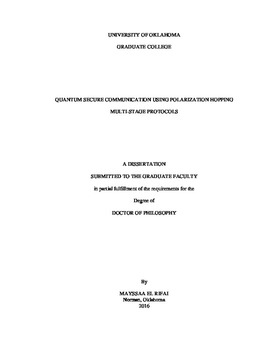| dc.contributor.advisor | Verma, Pramode K. | |
| dc.contributor.author | El Rifai, Mayssaa | |
| dc.date.accessioned | 2016-03-28T16:02:22Z | |
| dc.date.available | 2016-03-28T16:02:22Z | |
| dc.date.issued | 2016 | |
| dc.identifier.uri | https://hdl.handle.net/11244/33190 | |
| dc.description.abstract | This dissertation presents a study of the security and performance of a quantum communication system using multi-stage multi-photon tolerant protocols. Multi-stage protocols are a generalization of the three-stage protocol proposed in 2006 by Subhash Kak. Multi-stage protocols use “Polarization Hopping,” which is the process of changing the polarization state at each stage of transmission. During the execution of a multi-stage protocol, the message transfer always starts by encoding a bit of information in a polarization state; for example, bit 0 is encoded using state |0⟩ and bit 1 is encoded using state|1⟩ whereas, on the channel, the state of polarization is given by α|├ 0⟩┤+β|├ 1⟩┤. In the following α and β are restricted to the real numbers i.e., the polarization stays on the equator of the Poincare sphere. A transformation applied by one communicating party at a given stage will result in new values of α and β.
This dissertation analyzes the security of multi-stage, multi-photon tolerant protocols and proposes an upper bound on the average number of photons per pulse in the cases where Fock states and the cases where coherent states are used in the implementation of the three-stage protocol. The derived average number of photons is the maximum limit at which the three-stage protocol can operate at a quantum secure level while operating in a multi-photon domain. In addition, this dissertation studies the vulnerability of the multi-stage protocol to the Trojan horse attack, Photon Number splitting attack (PNS), Amplification attack, as well as the man-in-the middle attack. Moreover, this dissertation proposes a modified version of the multi-stage protocol. This modified version uses an initialization vector and implements a chaining mode between consecutive implementations of the protocol. The modified version is proposed in the case of the three-stage protocol and named a key/message expansion four variables three-stage protocol. The proposed nomenclature is based on the fact that an additional variable is added to secure the three-stage protocol. The introduction of this additional variable has the potential to secure the multi-stage protocol in the multi-photon regime. It results in the eavesdropper having a set of simultaneous equations where the number of variables exceeds the number of equations.
The dissertation also addresses the performance of the multi-stage, multi-photon tolerant protocol. An average photon number of 1.5 photon/stage is used to calculate the maximum achievable distance and key transfer rates while using the single-stage protocol over fiber optic cables. We compute the increase in distance as well as data transfer rate while using the single-stage protocol. Channel losses as well as the detector losses are accounted for.
Finally, an application of the multi-stage protocol in IEEE 802.11 is proposed. This application provides wireless networks with a quantum-level of security. It proposes the integration of multi-stage protocols into the four-way handshake of IEEE 802.11. | en_US |
| dc.language | en | en_US |
| dc.subject | Engineering, Electronics and Electrical. | en_US |
| dc.subject | Quantum communication | en_US |
| dc.subject | Three-stage protocol | en_US |
| dc.subject | Cryptography | |
| dc.title | QUANTUM SECURE COMMUNICATION USING POLARIZATION HOPPING MULTI-STAGE PROTOCOLS | en_US |
| dc.contributor.committeeMember | Chan, Kam Wai Clifford | |
| dc.contributor.committeeMember | Kak, Subhash | |
| dc.contributor.committeeMember | Macdonald, Gregory | |
| dc.contributor.committeeMember | Ray, William O. | |
| dc.contributor.committeeMember | Sluss, James J., Jr. | |
| dc.date.manuscript | 2016 | |
| dc.thesis.degree | Ph.D. | en_US |
| ou.group | College of Engineering::School of Electrical and Computer Engineering | en_US |
